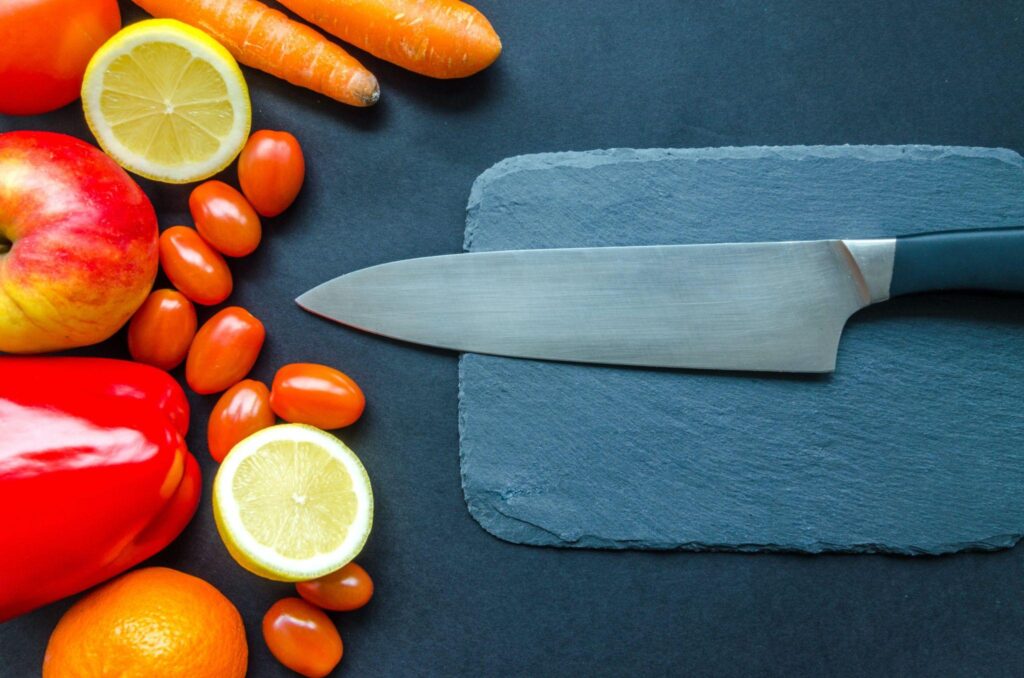
In the realm of culinary arts, particularly for meat enthusiasts, the right set of knives is paramount. Knives aren’t just practical gear; they’re a chef’s skill made tangible. Let’s dive into the knives you absolutely need if you’re serious about your meats, spotlighting what makes each one a cut above and how they stand out in the heat of the kitchen.
Chef’s Knife: The Multipurpose Master
Central to any kitchen is the chef’s knife. With a chef’s knife in hand, you’re set for any task—be it carving meats or mincing herbs—with its adept blade making every cut count. A quality chef’s knife typically features a sharp, slightly curved blade, combining stability and agility. High-carbon stainless steel stands out as the top pick for chef’s knives, thanks to its lasting sharpness and superb edge upkeep.
Butcher’s Knife: The Specialist for Raw Meats
But a butcher’s knife has a specific purpose. It’s designed for preparing raw meats. The long blade and curved shape let you easily slice cuts of beef, pork, poultry, and more. The sharp edge helps cut through sinew and cartilage. So while a chef’s knife can handle many kitchen tasks, a dedicated butcher’s knife excels at breaking down whole animals. Its specialty is getting those big primal and subprime cuts ready for cooking. If you regularly work with whole cuts of meat at home, a good butcher’s knife is essential. It makes the job easier and safer compared to using a smaller or duller blade. This specialty tool deserves a place in any carnivore’s kitchen!
Meat Cleaver: The Power Tool
For tougher tasks, such as chopping through bones, the meat cleaver is essential. A meat cleaver is built for forceful chops, letting it cut through thick cuts and bones cleanly without the risk of breaking.
This knife lets you cut through thick cuts and bone without dulling or damaging your other blades. It’s made for power, not detail work. So you can use it on chicken and tough meats, saving the precise knives for delicate tasks.
When selecting a meat cleaver, understanding its various aspects, such as blade geometry and handle design, is crucial. This knowledge can greatly influence the effectiveness and comfort during use. Resources such as detailed articles or guides similar to what might be found on The Cooking Guild can be invaluable. They help in discerning the subtle differences that might not be immediately noticeable but are crucial for specific culinary tasks.
Boning Knife: The Precision Instrument
The boning knife is indispensable for removing bones from meat. Its design – a flexible, narrow, and sharp blade – is tailor-made for precision. This knife is a pro at peeling meat off bones, navigating joints with ease, and nailing those meticulous cuts—a job that’d be way tougher and clumsier with something bulkier like a cleaver.
Slicing and Carving Knives: For Perfect Cuts
Slicing and carving knives are essential for achieving thin, even slices of cooked meat. These knives have long, narrow blades; the slicing knife usually features a rounded tip, while the carving knife tapers to a sharp point. The slicing knife is ideal for large, boneless meats like roasts, whereas the carving knife is more suited for poultry and bone-in cuts, providing precision similar to a boning knife but for cooked meats.
Utility Knife: The Versatile Companion
While the chef’s knife and the butcher’s knife handle most of the heavy lifting, the utility knife fills a vital niche for intermediate tasks. Nestled between the heft of a chef’s knife and the precision of a paring knife, this utility blade is your go-to for nailing those not-too-big, not-too-small kitchen tasks with ease. Nailing the cut on mid-sized veggies and fruits is a breeze with this knife, and it’s just as sharp for detailed jobs like filleting smaller fish or cutting away unwanted fat.
Paring Knife: The Detailing Expert
In the context of meat preparation, a paring knife’s value might not be immediately apparent. But its compact form and razor-sharp edge are ideal for the finer tasks, like removing shrimp veins, cutting away excess fat, or crafting fancy garnishes. Its small size and sharp blade make it ideal for more detailed jobs like taking veins out of shrimp, cutting off fat, or even making garnishes.
Sharpening and Maintenance: Ensuring Longevity
A key aspect often overlooked is the maintenance of these knives. Even the best knives lose their edge with use, and a dull knife can be more dangerous and less effective. Regular honing and occasional professional sharpening can maintain the edge and performance of your knives. Understanding the difference between honing (straightening the edge) and sharpening (actually grinding away metal to create a new edge) is crucial. Investing in a good honing steel and learning the correct technique can greatly extend the life of your knives.
Ergonomics and Handling: Comfort Meets Efficiency
Another important consideration is the ergonomics of the knife. How your knife feels in hand—from its weight to the handle’s shape—crucially shapes how comfortably and accurately you can chop. A well-balanced knife fits snug in your grip, eases the strain on your wrist, and sharpens the accuracy of each slice you make. Swinging by a shop to get a feel for different knives can really pay off, ensuring you pick one that meshes well with your style and keeps those chef skills sharp.
Specialty Knives: Exploring Niche Options
Beyond the basic set, there are specialty knives for those who wish to expand their collection. Examples include a Nakiri knife, ideal for chopping vegetables, or a Santoku knife, which is a Japanese all-purpose knife similar to a chef’s knife but with a different blade shape. Sure, you don’t strictly need these knives, but they can seriously spice up your cooking game and bring more fun to the table.
Adding these extra knives and tricks to your cooking routine not only speeds up prepping meat but also ramps up the fun. Choosing the right knife isn’t just about getting cleaner cuts—it’s also key to unlocking new culinary possibilities and elevating your cooking game.




Leave a Reply